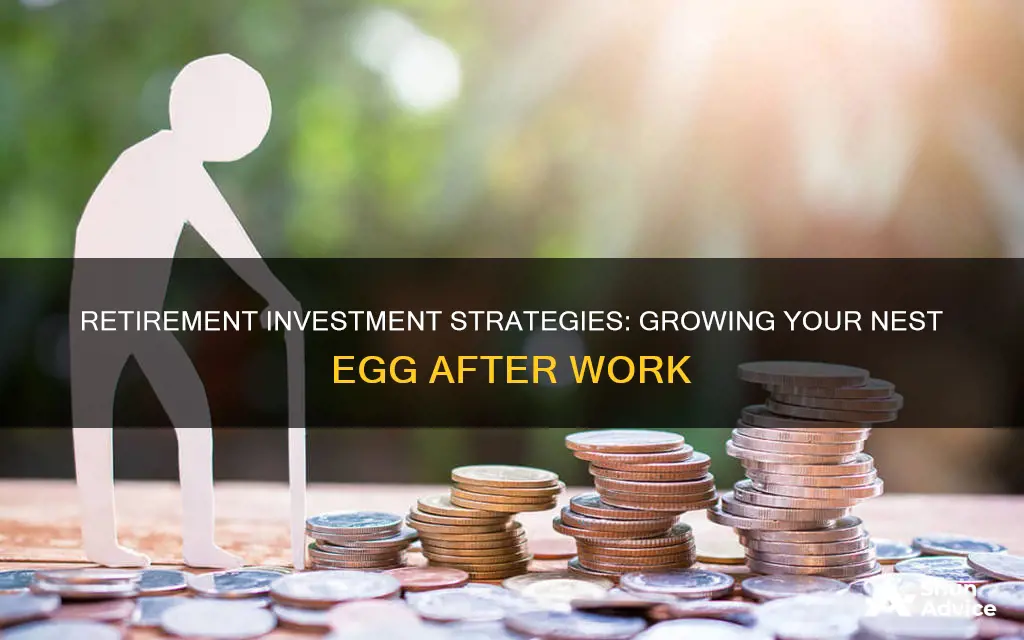
With people living longer, retirees need to ensure their savings last for 20 to 30 years or more. This means retirees need to continue growing their investments to keep up with rising living costs. A financial professional can help retirees determine the most appropriate retirement income strategy for their circumstances. There are several investment options to help generate retirement income, including annuities, a diversified bond portfolio, a total return investment approach, and income-producing equities.
| Characteristics | Values |
|---|---|
| Average retirement age | 65 |
| Average life expectancy for a 65-year-old in the US | 85 |
| Average retirement duration | 20-30 years |
| Average inflation rate | 3% |
| Average interest rates | Variable |
| Social Security retirement benefits | 40% of pre-retirement earnings |
| Pension, savings and investment requirements | Supplementing Social Security retirement benefits |
| Investment options | Income annuity, diversified bond portfolio, total return investment approach, income-producing equities |
| Investment risks | Volatility, liquidity, inflation, interest rates, taxes |
| Investment goals | Growth, income, capital preservation |
What You'll Learn

Annuities
People typically buy annuities to help manage their income in retirement. Annuities provide three things:
- Periodic payments for a specific amount of time, which may be for the rest of your life, or the life of your spouse or another person.
- Death benefits. If you die before you start receiving payments, the person you name as your beneficiary will receive a specific payment.
- Tax-deferred growth. You pay no taxes on the income and investment gains from your annuity until you withdraw the money.
There are three basic types of annuities: fixed, variable, and indexed.
- Fixed annuity: The insurance company promises you a minimum interest rate and a fixed amount of periodic payments.
- Variable annuity: The insurance company allows you to direct your annuity payments to different investment options, usually mutual funds. Your payout will depend on how much you put in, the rate of return on your investments, and expenses.
- Indexed annuity: This annuity combines features of securities and insurance products. The insurance company credits you with a return that is based on a stock market index, such as the Standard & Poor's 500 Index.
When considering an annuity, it is important to remember that they can be complex and may have high fees. It is recommended that you consult with a financial advisor to understand the pros and cons of the various types of annuities available to you.
Investing: Is It Right for Your Money?
You may want to see also

High-yield savings accounts
Benefits
- High APYs compared to other types of deposit accounts.
- Low fees, especially with online-only banks.
- High returns without high risks.
- Easy to find accounts with zero monthly fees and low or no minimum requirements.
- Some accounts offer ATM cards for convenient access to your money.
Things to Consider
When choosing a high-yield savings account, there are a few things to keep in mind:
- Interest rates can change at any time, especially when the Fed makes interest rate adjustments.
- Some accounts have stricter requirements than traditional savings accounts, such as minimum deposit or balance requirements.
- Not all accounts offer ATM cards, and most accounts are online-only with limited to no in-person banking options.
- Transfers between accounts can take 24 to 48 hours.
Examples of High-Yield Savings Accounts
- CIT Bank's Platinum Savings account: 5% yield on a balance of $5,000 or more.
- Sallie Mae's high-yield savings account: 4.5% return with no minimum deposit.
- LendingClub: 5% yield on a minimum deposit of $100.
- UFB Direct: 5.25% APY with no monthly fee and no minimum balance requirements.
- Bask Bank: 5.10% APY with no monthly fee, no minimum deposit, and no maximum deposit amount.
Rubles: Worth the Investment Risk?
You may want to see also

Diversification
A diversified portfolio holds asset classes with exposure to different parts of the market, with varying degrees of correlation. This means that some assets might move similarly, while others won't, limiting the risk of big swings in overall portfolio value. For example, if an investor has exposure to two negatively correlated areas of the market, assets in one area may hold steady or even rise, while assets in the other may underperform. As such, portfolios with negatively correlated assets are better equipped to mitigate risk and volatility.
There are various methods to construct a diversified portfolio, but all should start with the right asset allocation—the mix of stocks, bonds, cash, and other asset classes in an investment portfolio. This asset allocation should be customized to match personal factors such as health, investment time horizon, and financial objectives.
Mutual funds can offer a convenient and effective way to achieve broad portfolio diversification. However, every fund has a specific investment mandate, such as capital preservation or aggressive growth, and their static nature doesn't always guarantee the right level of diversification needed to reach your financial goals. Additionally, investing in many funds can expose your portfolio and retirement goals to unforeseen risks and inefficiencies.
- Diversification with fixed income and equity allocations: It is generally optimal to have some fixed income and some equity in your portfolio, as this provides flexibility for rebalancing. The allocation between the two depends on your individual circumstances.
- Diversification with account types: Having different account types with different tax implications can potentially reduce your overall tax liability and provide flexibility with distributions.
- Diversification with domestic and foreign investments: Investing in both domestic and foreign markets allows you to benefit from returns all over the world. The top-performing countries for equity vary from year to year, so having exposure to a variety of countries can be advantageous.
- Diversification with investment holdings: Investing in a multitude of holdings spreads out risk and reduces overall risk. ETFs or mutual funds are a good way to achieve full diversification.
It is important to note that diversification has its limits, and there is a point beyond which a portfolio can be over-diversified. Over-diversification can lead to issues such as the inability to outperform the market, lack of personalization, over-concentration of stock holdings, and conflicting decisions between fund managers. Therefore, it is crucial to periodically check and rebalance your portfolio to ensure it remains aligned with your investment goals and risk tolerance.
Investors: Money Masters or Risk-Takers?
You may want to see also

Tax efficiency
- The Traditional Approach: This approach involves starting your withdrawals from taxable accounts, paying any applicable taxes, and then moving on to tax-deferred accounts like traditional IRAs or 401(k)s. While this method is simple and straightforward, it's important to remember that once you reach the age for required minimum distributions (RMDs), you'll need to start withdrawing from your tax-deferred accounts, which can result in a spike in your income and the amount of tax you owe.
- The Proportional Approach: This strategy involves making withdrawals from both your taxable accounts and tax-deferred accounts proportionally, based on the account balances. This approach can help smooth out your taxable income in retirement and reduce the spike in income caused by RMDs, ultimately lowering the total taxes paid over your retirement.
- Live in a Tax-Friendly State: Consider relocating to a state with no income tax or low income taxes. Eight states have no income tax: Alaska, Florida, Nevada, South Dakota, Tennessee, Texas, Washington, and Wyoming. Additionally, three states—Illinois, Mississippi, and Pennsylvania—offer special breaks for retirement income.
- Reassess Your Investments: You may want to change your investment holdings to save on taxes and preserve your principal. For example, interest on municipal bonds is typically free from federal income tax. Qualified dividends from certain corporations are taxed at more favourable rates than ordinary income. Additionally, you can use losses on the sale of securities to offset capital gains and reduce your tax burden.
- Avoid or Postpone RMDs: If you're 73 or older, you can avoid paying tax on RMDs from your traditional IRA by transferring the funds directly to a charity, up to $100,000 annually. Alternatively, you can invest in a qualified longevity annuity contract (QLAC) within your IRA or 401(k) to postpone RMDs and ensure a steady income stream later in life.
- Be Strategic About Social Security Benefits: If you don't need Social Security benefits at full retirement age, consider delaying them until age 70. By doing so, you'll earn additional credits and boost your monthly benefits. Additionally, you won't have to pay taxes on the benefits at that time.
- Diversify Your Retirement Accounts: Use a mix of account types with different tax treatments to control your taxable income in retirement. This includes tax-deferred accounts like 401(k)s and traditional IRAs, Roth accounts like Roth 401(k)s and Roth IRAs, traditional bank and brokerage accounts, and health savings accounts (HSAs). The right mix will depend on factors like your current tax bracket and expected future tax rate.
- Consider a Roth Conversion: If your income is too high to contribute to a Roth IRA, you can convert funds from a traditional IRA to a Roth IRA and pay taxes on the converted amount. This strategy can help diversify your tax treatments and provide more flexibility in retirement.
- Invest Tax-Efficiently in a Brokerage Account: If you have additional funds after maximising tax-advantaged accounts, consider investing in a traditional brokerage account. Employ strategies such as holding appreciated investments for the long term to take advantage of lower long-term capital gains tax rates, limiting investment trades to avoid unnecessary taxes, and considering tax-efficient investments like exchange-traded funds and index mutual funds.
Market Volatility: Navigating the Investment Storm
You may want to see also

Low-risk investments
Income is a priority for retirees, and low-risk investments can help them achieve financial security. Here are some of the best low-risk investment options for retirees:
High-yield savings accounts
While not technically an investment, high-yield savings accounts offer a modest and safe return on your money. These accounts are government-insured, so you don't have to worry about losing your funds. The interest rate environment is currently attractive, allowing these accounts to earn meaningful interest with very limited risk.
Money market funds
Money market funds are pools of low-risk investments, such as CDs and short-term bonds, that are grouped together to diversify risk. They are typically liquid, allowing you to access your funds without penalties. These funds are considered pretty safe and stable, making them a good option for retirees.
Short-term certificates of deposit (CDs)
CDs are loss-proof in FDIC-backed accounts, as long as you don't withdraw the money early. They offer a fixed interest rate for a specific period, providing income stability. However, the liquidity of CDs is lower than other investments, and you may face penalties for early withdrawal.
Series I savings bonds
Series I savings bonds are a type of low-risk bond that adjusts for inflation. When inflation rises, the bond's interest rate is adjusted upward, protecting your investment. These bonds are backed by the US government and can be purchased through TreasuryDirect.gov.
Treasury bills, notes, bonds, and TIPS
Treasury bills, notes, and bonds are highly liquid securities issued by the US Treasury. They have different maturity dates, ranging from one year to 30 years. TIPS (Treasury Inflation-Protected Securities) are securities whose value adjusts with inflation. These options are generally lower risk, but it's important to consider that their value can fluctuate with interest rates.
Dividend-paying stocks
Dividend-paying stocks offer a consistent income stream through regular dividend payments. They also have the potential for capital appreciation, helping retirees keep up with inflation. Including these stocks in a retirement portfolio can add diversification and enhance overall returns. However, dividend-paying stocks come with greater volatility and risk compared to bonds and CDs.
Fixed Annuities
Annuities are contracts, often with insurance companies, that provide a guaranteed income stream over a specific period. They offer tax-deferred growth and can be structured to meet your needs, such as providing income for a fixed period or until death. Annuities also come with benefits like death benefits and minimum guaranteed payouts. However, they can be complex and illiquid, with significant penalties for early withdrawal.
Renewable Energy's Return: Does Green Energy Pay Dividends?
You may want to see also
Frequently asked questions
Low-risk investments for retirees include high-yield savings accounts, money market funds, and Treasury Inflation-Protected Securities (TIPS).
A common strategy for investing in retirement is to hold a balanced portfolio of stocks, bonds, and cash investments. This approach aims to provide growth and income to meet spending needs and sustain the portfolio over the long term.
It is important to consider your timeline, risk tolerance, income needs, financial goals, and time horizon. Additionally, having a clear plan for how to afford living on a fixed income and understanding where and how your cash is invested are crucial.







